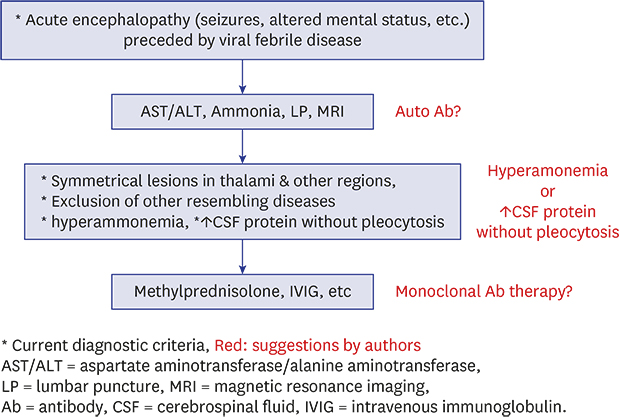1. Mizuguchi M, Abe J, Mikkaichi K, Noma S, Yoshida K, Yamanaka T, et al. Acute necrotising encephalopathy of childhood: a new syndrome presenting with multifocal, symmetric brain lesions. J Neurol Neurosurg Psychiatry. 1995; 58(5):555–561.

2. Mizuguchi M. Acute necrotizing encephalopathy of childhood: a novel form of acute encephalopathy prevalent in Japan and Taiwan. Brain Dev. 1997; 19(2):81–92.

3. Wang HS. Reports of acute encephalopathy with bilateral thalamotegmental involvement. AJNR Am J Neuroradiol. 1996; 17(2):398–399.
4. Aydin H, Ozgul E, Agildere AM. Acute necrotizing encephalopathy secondary to diphtheria, tetanus toxoid and whole-cell pertussis vaccination: diffusion-weighted imaging and proton MR spectroscopy findings. Pediatr Radiol. 2010; 40(7):1281–1284.

5. Komur M, Okuyaz C, Arslankoylu AE, Kara E, Atici A. Acute necrotizing encephalopathy associated with novel influenza A (H1N1) virus in Turkey. J Pak Med Assoc. 2011; 61(12):1237–1239.
6. Lyon JB, Remigio C, Milligan T, Deline C. Acute necrotizing encephalopathy in a child with H1N1 influenza infection. Pediatr Radiol. 2010; 40(2):200–205.

7. Mariotti P, Iorio R, Frisullo G, Plantone D, Colantonio R, Tartaglione T, et al. Acute necrotizing encephalopathy during novel influenza A (H1N1) virus infection. Ann Neurol. 2010; 68(1):111–114.

8. Mastroyianni SD, Gionnis D, Voudris K, Skardoutsou A, Mizuguchi M. Acute necrotizing encephalopathy of childhood in non-Asian patients: report of three cases and literature review. J Child Neurol. 2006; 21(10):872–879.

9. Yildizdaş D, Kendirli T, Arslanköylü AE, Horoz OO, Incecik F, Ince E, et al. Neurological complications of pandemic influenza (H1N1) in children. Eur J Pediatr. 2011; 170(6):779–788.

10. Gika AD, Rich P, Gupta S, Neilson DE, Clarke A. Recurrent acute necrotizing encephalopathy following influenza A in a genetically predisposed family. Dev Med Child Neurol. 2010; 52(1):99–102.

11. Neilson DE. The interplay of infection and genetics in acute necrotizing encephalopathy. Curr Opin Pediatr. 2010; 22(6):751–757.

12. Singh RR, Sedani S, Lim M, Wassmer E, Absoud M. RANBP2 mutation and acute necrotizing encephalopathy: 2 cases and a literature review of the expanding clinico-radiological phenotype. Eur J Paediatr Neurol. 2015; 19(2):106–113.
13. Sondhi V, Chakrabarty B, Kumar A, Kohli S, Saxena R, Verma IC, et al. RANBP2 mutation in an Indian child with recurrent acute necrotizing encephalopathy. Brain Dev. 2016; 38(10):937–942.
14. Wolf K, Schmitt-Mechelke T, Kollias S, Curt A. Acute necrotizing encephalopathy (ANE1): rare autosomal-dominant disorder presenting as acute transverse myelitis. J Neurol. 2013; 260(6):1545–1553.

15. Lee YJ, Hwang SK, Lee SM, Kwon S. Familial acute necrotizing encephalopathy with RANBP2 mutation: the first report in Northeast Asia. Brain Dev. 2017; 39(7):625–628.
16. Martin A, Reade EP. Acute necrotizing encephalopathy progressing to brain death in a pediatric patient with novel influenza A (H1N1) infection. Clin Infect Dis. 2010; 50(8):e50–2.

17. Neilson DE, Adams MD, Orr CM, Schelling DK, Eiben RM, Kerr DS, et al. Infection-triggered familial or recurrent cases of acute necrotizing encephalopathy caused by mutations in a component of the nuclear pore, RANBP2. Am J Hum Genet. 2009; 84(1):44–51.
18. Denier C, Balu L, Husson B, Nasser G, Burglen L, Rodriguez D, et al. Familial acute necrotizing encephalopathy due to mutation in the RANBP2 gene. J Neurol Sci. 2014; 345(1-2):236–238.
19. Ochi N, Takahashi K, Yamane H, Takigawa N. Acute necrotizing encephalopathy in an adult with influenza A infection. Ther Clin Risk Manag. 2018; 14:753–756.

20. Mungaomklang A, Chomcheoy J, Wacharapluesadee S, Joyjinda Y, Jittmittraphap A, Rodpan A, et al. Influenza virus-associated fatal acute necrotizing encephalopathy: role of nonpermissive viral infection? Clin Med Insights Case Rep. 2016; 9:99–102.

21. Okumura A, Abe S, Kidokoro H, Mizuguchi M. Acute necrotizing encephalopathy: a comparison between influenza and non-influenza cases. Microbiol Immunol. 2009; 53(5):277–280.

22. Samanta D. Influenza B-associated acute necrotizing encephalopathy of childhood: a report from North America. Acta Neurol Belg. 2016; 116(3):383–385.

23. Tabarki B, Thabet F, Al Shafi S, Al Adwani N, Chehab M, Al Shahwan S. Acute necrotizing encephalopathy associated with enterovirus infection. Brain Dev. 2013; 35(5):454–457.

24. Ventura E, Summa A, Ormitti F, Picetti E, Crisi G. Influenza A H1N1 related acute necrotizing encephalopathy: radiological findings in adulthood. Neuroradiol J. 2012; 25(4):397–401.

25. Wu X, Wu W, Pan W, Wu L, Liu K, Zhang HL. Acute necrotizing encephalopathy: an underrecognized clinicoradiologic disorder. Mediators Inflamm. 2015; 2015:792578.

26. Hoshino A, Saitoh M, Miyagawa T, Kubota M, Takanashi JI, Miyamoto A, et al. Specific HLA genotypes confer susceptibility to acute necrotizing encephalopathy. Genes Immun. 2016; 17(6):367–369.

27. Yoshida T, Tamura T, Nagai Y, Ueda H, Awaya T, Shibata M, et al. MRI gadolinium enhancement precedes neuroradiological findings in acute necrotizing encephalopathy. Brain Dev. 2013; 35(10):921–924.

28. Kansagra SM, Gallentine WB. Cytokine storm of acute necrotizing encephalopathy. Pediatr Neurol. 2011; 45(6):400–402.

29. Shirai T, Fujii H, Ono M, Watanabe R, Shirota Y, Saito S, et al. A novel autoantibody against ephrin type B receptor 2 in acute necrotizing encephalopathy. J Neuroinflammation. 2013; 10(1):128.

30. Mizuguchi M. Acute necrotizing encephalopathy. Nihon Rinsho. 2011; 69(3):465–470.

31. Skelton BW, Hollingshead MC, Sledd AT, Phillips CD, Castillo M. Acute necrotizing encephalopathy of childhood: typical findings in an atypical disease. Pediatr Radiol. 2008; 38(7):810–813.

32. Okumura A, Mizuguchi M, Kidokoro H, Tanaka M, Abe S, Hosoya M, et al. Outcome of acute necrotizing encephalopathy in relation to treatment with corticosteroids and gammaglobulin. Brain Dev. 2009; 31(3):221–227.











 PDF
PDF Citation
Citation Print
Print




 XML Download
XML Download